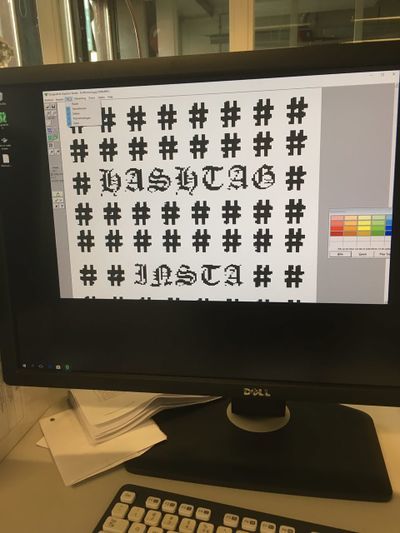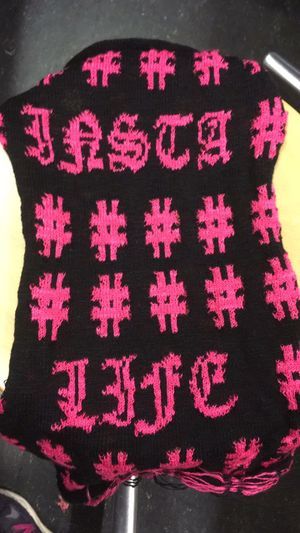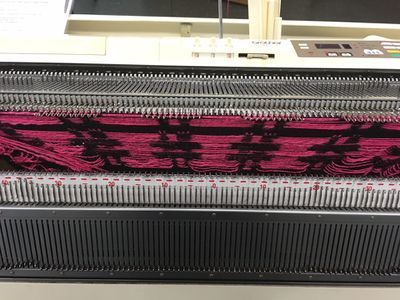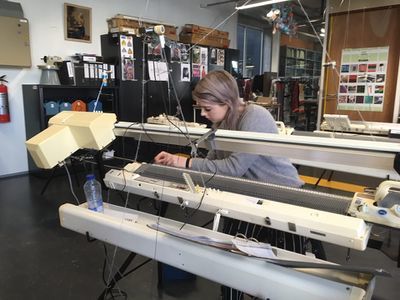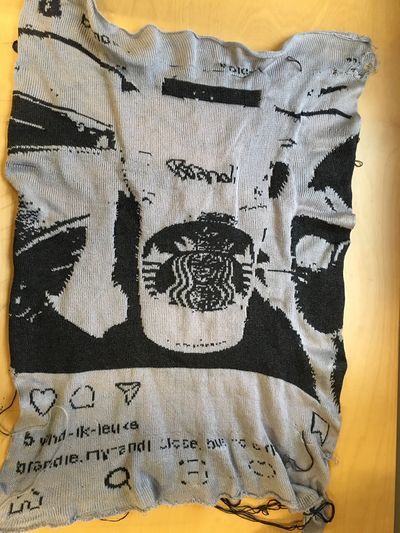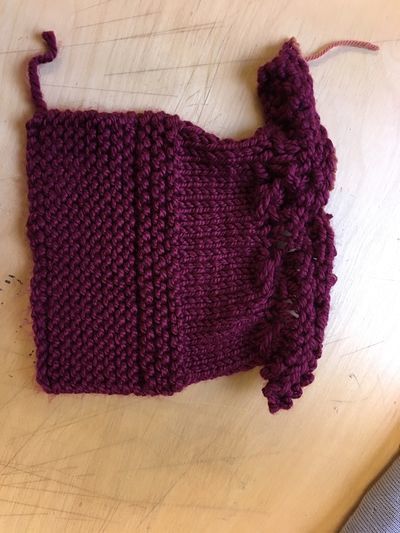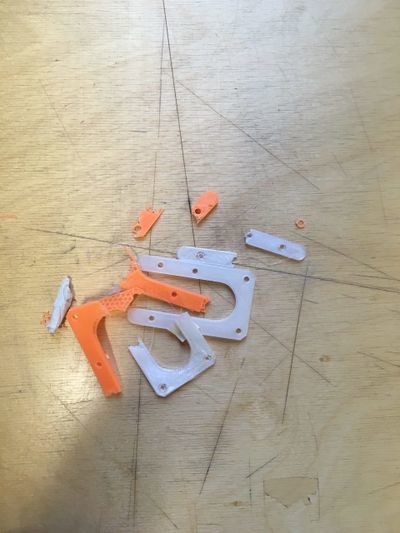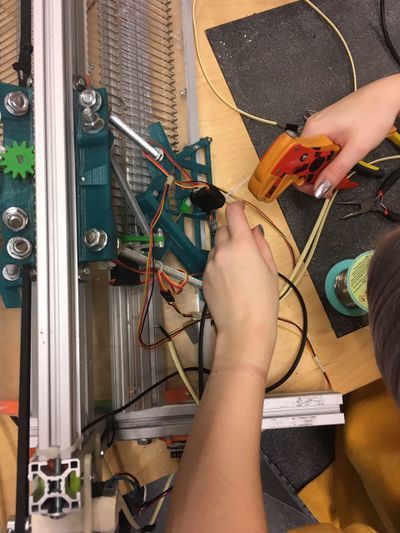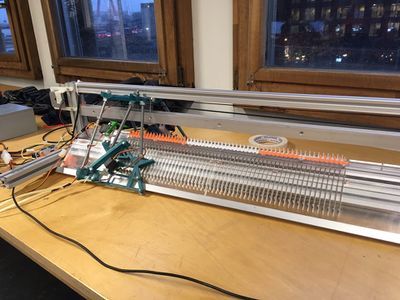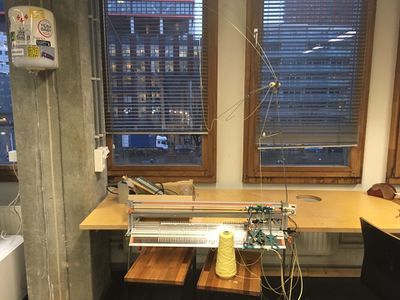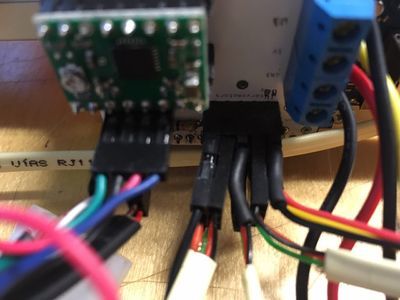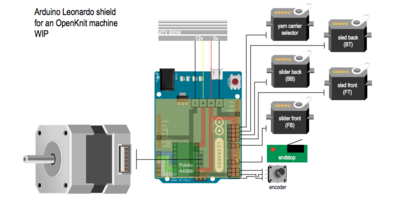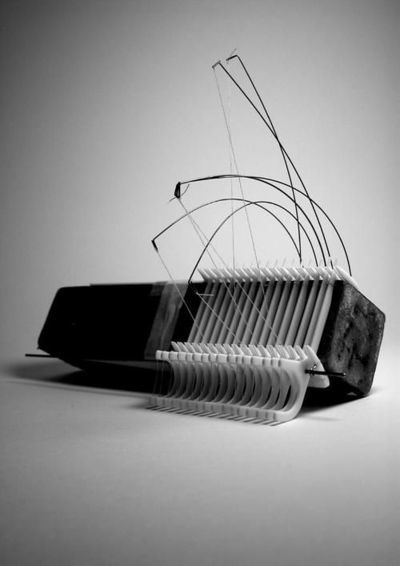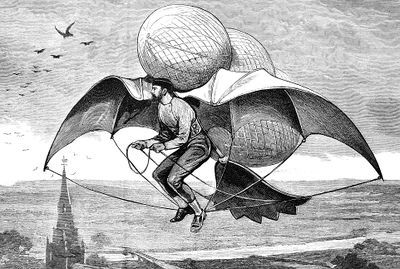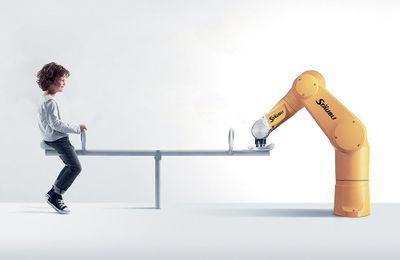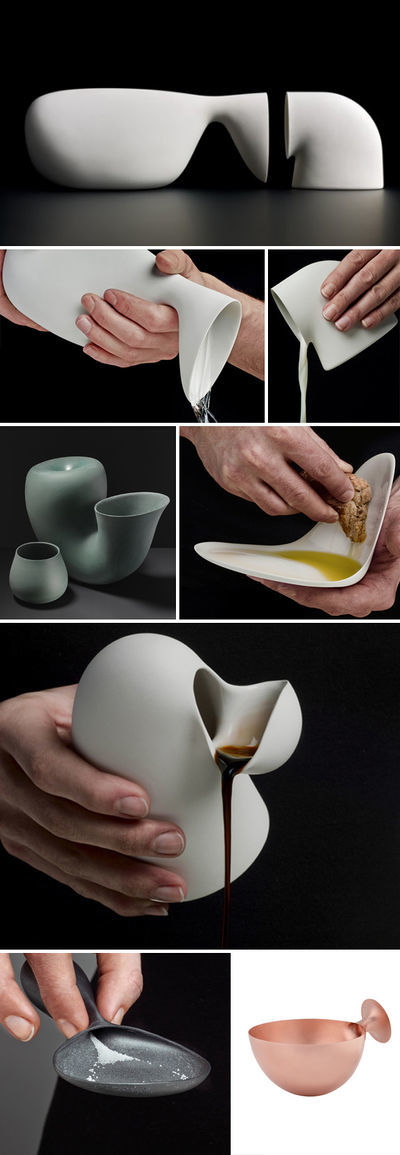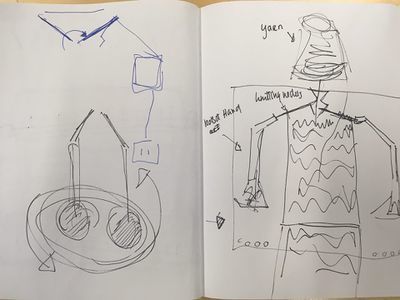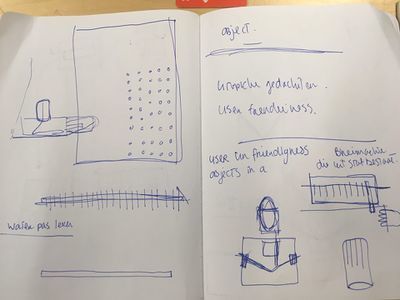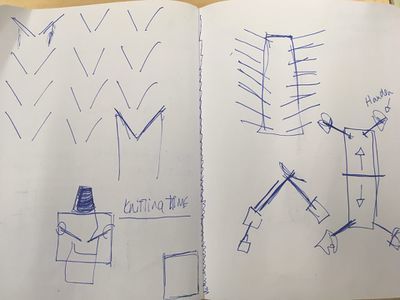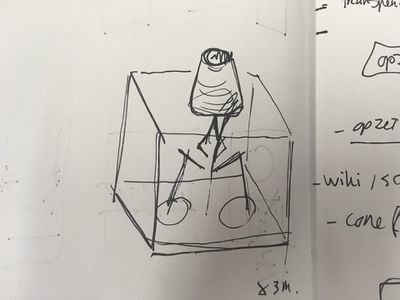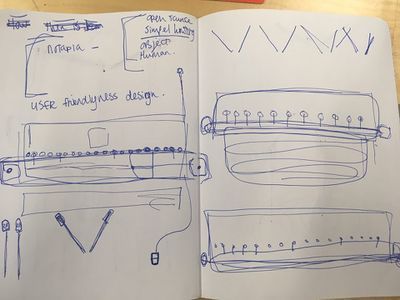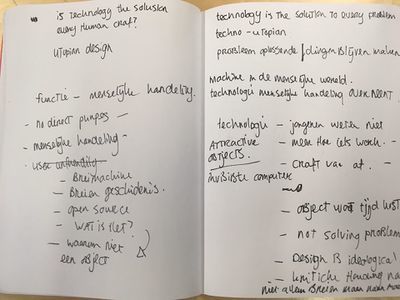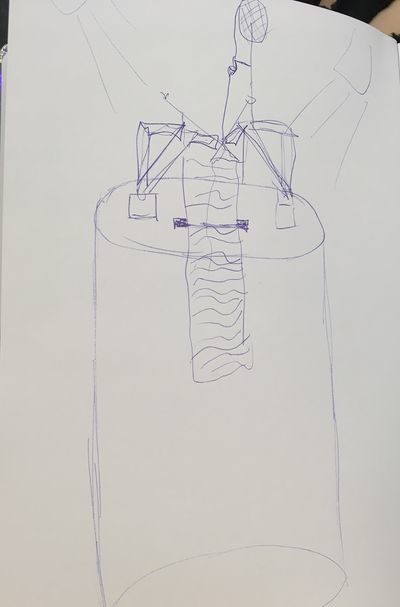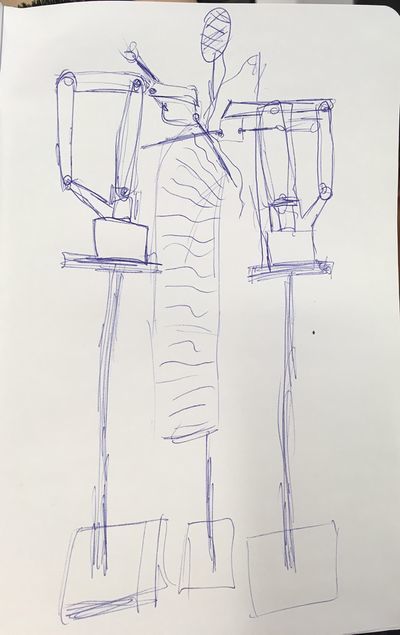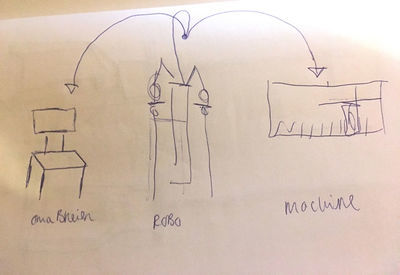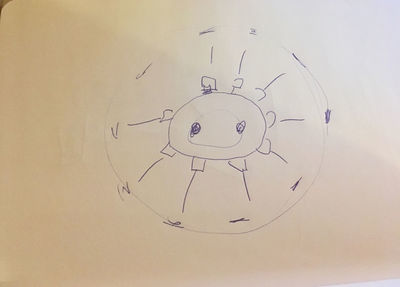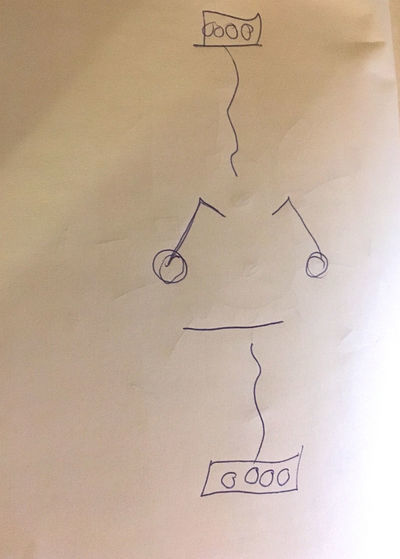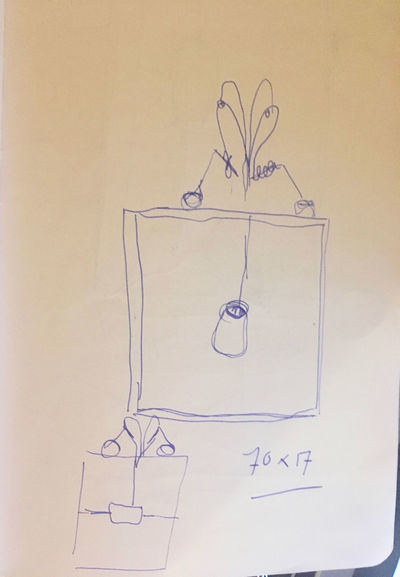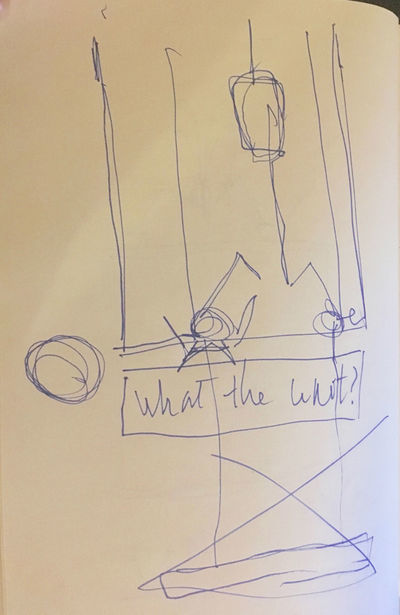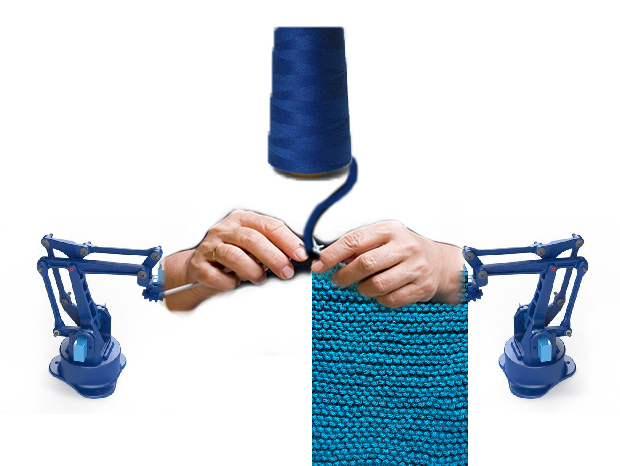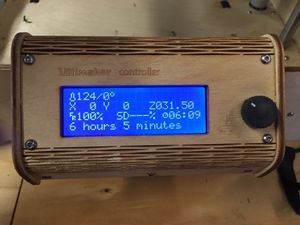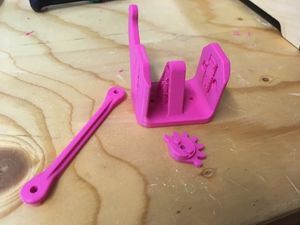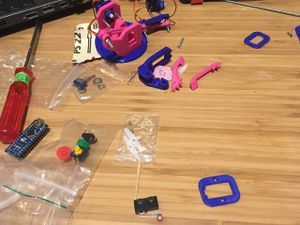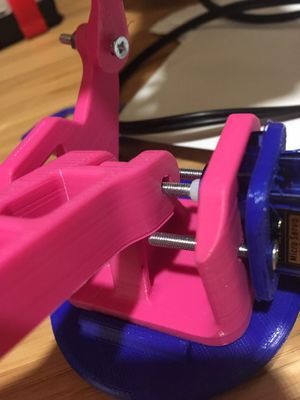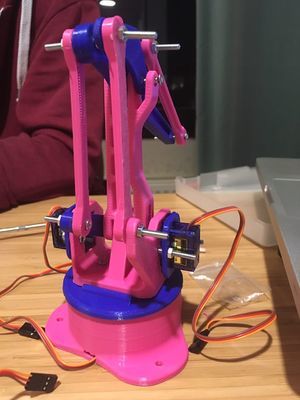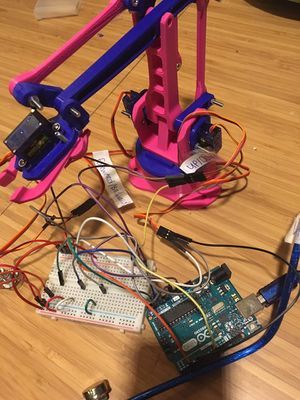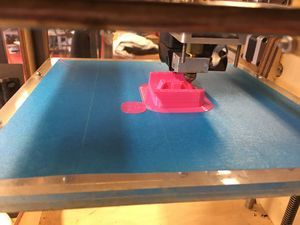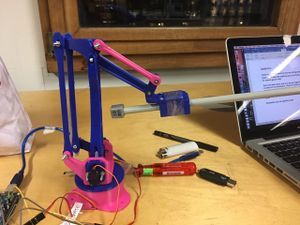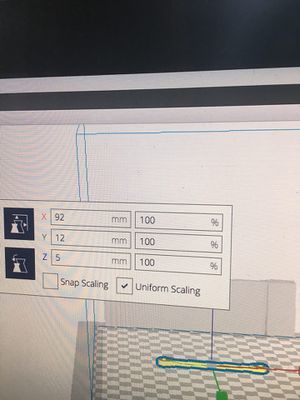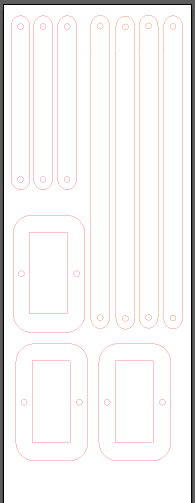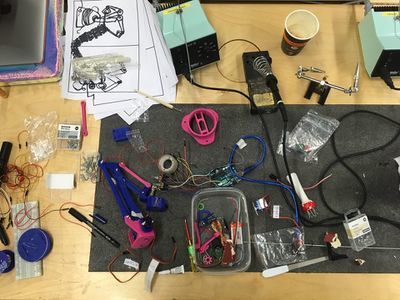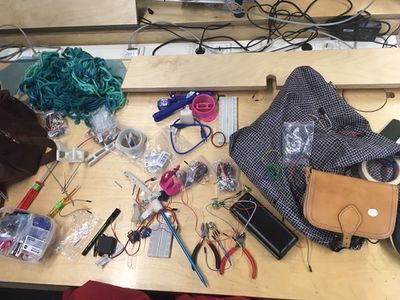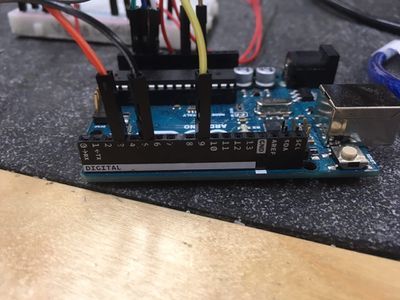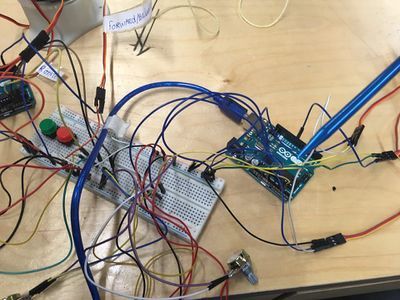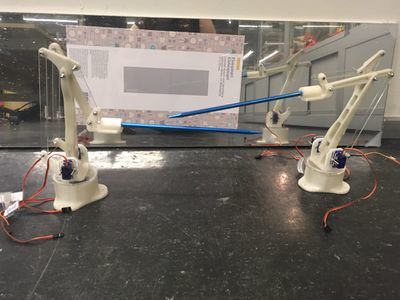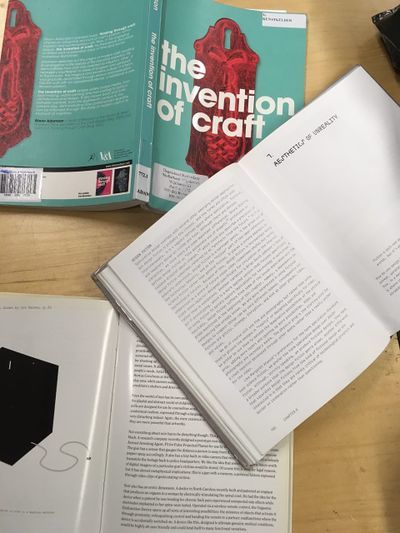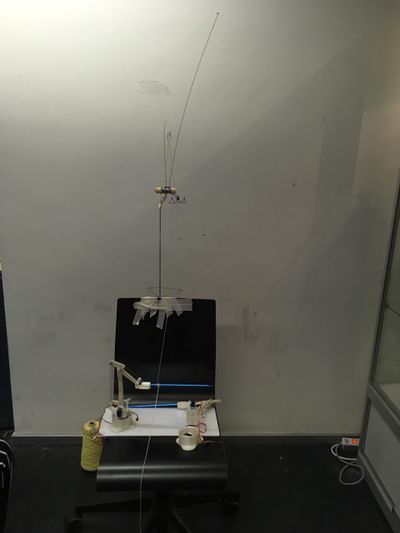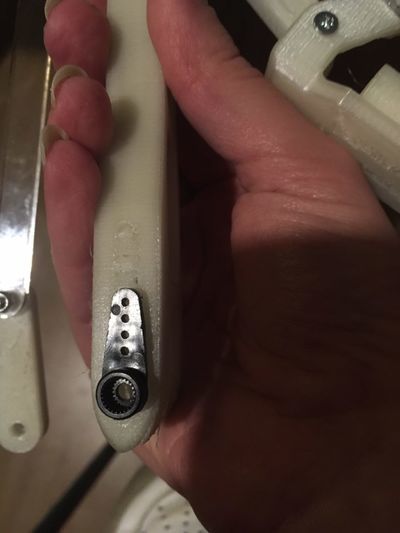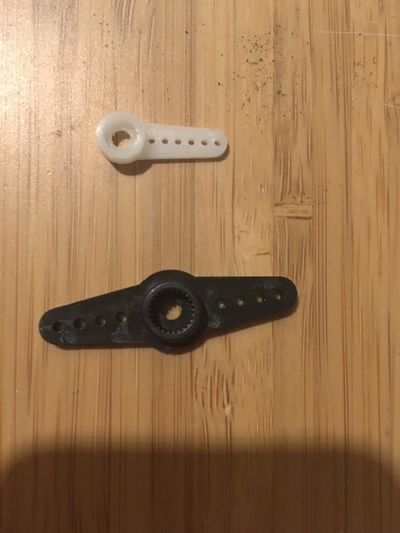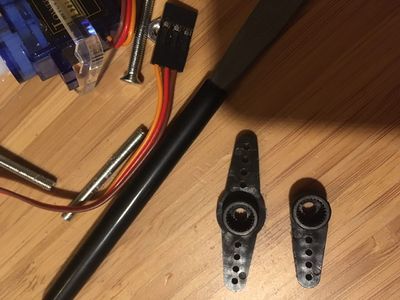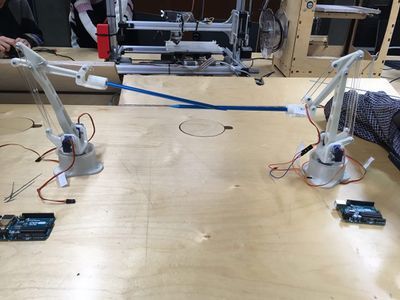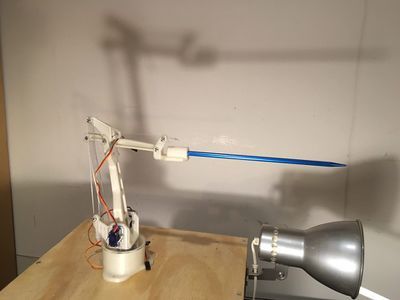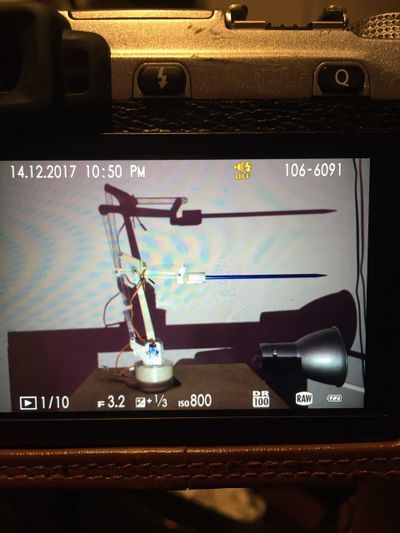User:SuzanneGuitjens/Knitting
Contents
start
Start knitting on a brother KH900. - try to knitting a Instagram post -
Exploring how the knitting machine works.
We worked with Photoshop and a special knitting program that is not very easy to use.
After 1 day of spending with this computer program we had some idea of how this program works.
I knitted a instagram post of #starbucksnamefail, the post is not super clear but you can see what it is.
Also we knitted by hand and tried a few different stitches.
Starting with the OPEN KNIT machine
the Open Knit machine started as a open source project ended in closed machine with a very bad software program. We starting with understanding this open knit machine we soldering everything again, change the 3D printing stuff, and looked at the servo + Arduino code. it. So fast that we talk about to make our own knitting machine. explanation follow later.. in change of plans. The people that worked on the machine last didn't really understand knitting or thought it was interesting enough and didn't got it to work again. We adopted this machine and printed new parts and soldered the cables. We worked on this machine for 2 weeks very day.
the knitting machine
We adopt a DIY knit machine, a very shitty and neglected knit machine.
But we love it, and give him his life and personality back.
So he had some issues with himself a frustration, maybe because he was
Neglected. The communication between him and human was very sad and disappointed.
But (we) the human had an expiation of this machine, like a child how have to grow up and try to bicycle. Why use humans this DIY anyway? We know it is a bit a utopic idea to make everything yourself and machines or objects open source. It is most of the time in concept and it work halfway and it is also most of the time user-unfriendly and not always well documented. When you know nothing about for example digital machines, programming and 3D printing at all. They documented there work but don’t explain why?
Here is a picture of the open source knitting machine VS the kniterate (same connect but than not open source)
http://openknit.org/
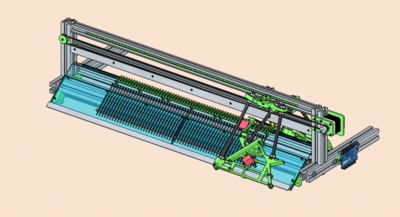
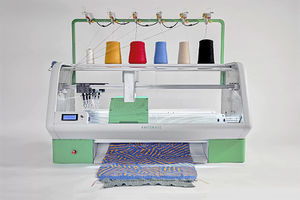
Kintting hack, making glichknit
http://www.glitchknit.jp
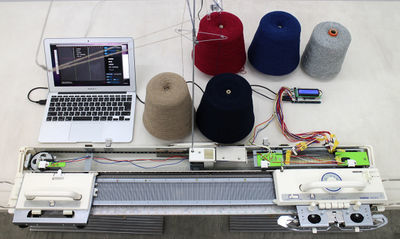
Just a knitting machine 2side knitting

First we went to the normal knitting machine at the fabric station where we can make everything what we want but not open source. With the open knit we can make everything open source but not what we want. There is a big gab between the machine and the user. Between the programmer and the audients to use the machine.
We ask Gera (master knitting at the fabric station) why she don’t use the open kit (the shitty machine) and she say: ‘’the machine is not based on how knitting is working’’
This gab between a user and familiar with knitting and a geek how to know to building a machine without knowing of the user. You could see a big different between the two machines by who made them, the knitting machine at the fabric station are made by people who know about knitting and you can knit everything with the machine.
The shitty machine works kind of the same but is made by people who know about electronics but not about knitting and the machine can knit but the result is pretty crappy.
When we work whit the open knit, and people ask what it is we tell them it is a knitting machine. They didn’t believe it or didn’t get the point of this knitting machine. So why should we make an artwork based on this knitting machine? I think it is a beautiful metaphor to give a critic on how we create objects or machines. They don’t look like a knitting machine but as an object a as human. A lot of machines and object don’t look like the machine or object that we would imagine with the role of that machine or object.
Like the Wooden espresso machine from Oystein Helle Husby, the machine is very pretty but you can’t recognize what is it. If you think about a coffee machine the first think that pops up is the filter coffee machine because that’s the machine we know the best.
And when you ask people if you think about knitting what kind of image do you see?
And most people think about knitting with needles by hand. That is the image people have about knitting.
http://www.oysteinhusby.com/ -Oystein Helle Husby
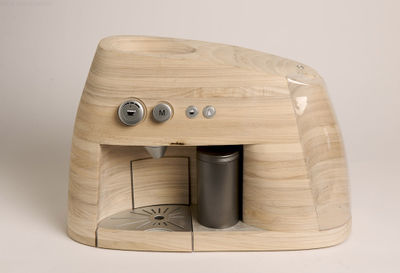
What this open knit machine was in the first place. This open knit machine [1] was made by a couple of humans as a DIY project. At the instructables [2] standing an explanation of how to build an open knit machine. The open knit was a success and they made a better version [3]
A project that is standing on kick-starter now. Even the knitting machine has some success they didn’t put everything online like the shield on the Arduino and also the software is pretty shitty to. There is no access to create a designer or a designer perspective. Also the open source is lost. When we talked about open source
I didn’t know anything about it. For me, I have always some utopic images in my head when I think about a knitting machine. This image in my head is every time some robotic hands with kitting needles in their hands that try to do a human action/moving to create a knitting piece.
Why should I use the shitty knit machine instead of the user-friendly machine?
And even the user-friendly machine is not so friendly as it looks.
This project is not about the open kit machine but about why we design objects related to human actions but not look like a human interaction at all. We at the academy learn how to shape a design and combine differed options, create concepts that in theory could work. But an object that works in theory is not always the best solution.
We don’t want to create the best solution but awareness of the fact we create objects/machines that makes the craft but not how it supposes to be if human hand is would do it. Antony Dunne and Fiona Raby talk about Notopia. It is not a utopia or dystopia but they talk about that we think technology / machines could save the world but they don’t do it. So, we want to create a machine or human action what can create a human craft without knowing it is a human knitter machine and maybe this machine fails in knitting. but it doesn’t matter, the object it self is a solution to see how our imagination is when we talk about a knitting machine. It could save the world, but in conceptual idea of ‘stel je voor dat’ is this the idea about the humanizer knitting machine.
The conceptual part of it is or isn’t. the chair is an example of this. The chair can be a physical object, it can be an explanation as a text, it can be a photo at a poster. If it can explain what the chair will be it is a chair. The same for the knitting machine.
A human that is knitting is also a human machine at them self how is knitting, a robot hand that tries to find the human flow to knit as a human. Or a knitting machine that don’t look as a knitting machine but can produce the same as the object and the human them self.
Design Noir: The Secret Life of Electronic Objects
Book by Anthony Dunne and Fiona Raby
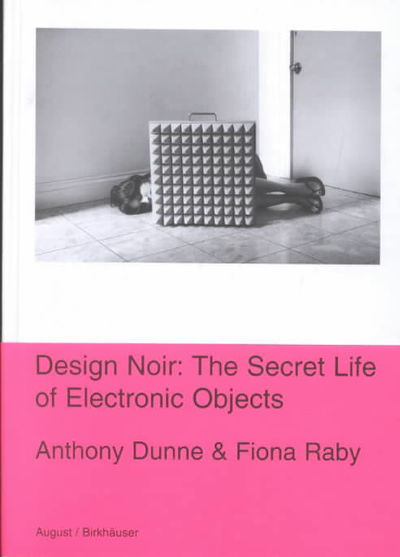
Design noir: the secret life of electronica objects describes the The notopia in the first part off the book. “ happy-ever-after” where technology is the solution of every problem. Maybe we felt lonely without al this machines. And we can’t be happy anymore. We didn’t realize how many things and objects we have in live and have some relation with it. The notopia is for us, so maybe it will bring us farther away from the reality of the craft, like the knitting object. But maybe we find a buddy to knit with when we are lonely or dreaming to have some object in our imagination that is the reality for now.
The object what we create now is between the human and machine. It doesn’t have a conciseness but it has a goal to produce without knowing it. Even we don’t know what this machine is able to lean or feel why the need to move as a human. We think it will felt lonely because it is counter clockwise. It is the object that has to learn by doing what a human thing is to do. Also we had a discussion is this machine right or left-handed. It gives some emotional feeling, of course you can say right-handed. But can you give me an example of a right-handed machine? that’s the point when you knit you have to choose a side. As a human being you know you left or right handed. A machine or object doesn’t even know till you say what, what is.
Nicholas Szczepaniak – A Defensive Architecture
The proposal suggests that mega structures can be integrated into, and encourage, the growth of natural defence mechanisms.
Not every Victorian flying machine idea was practical or feasible, as is demonstrated by this speculative illustration from The Graphic of December 1877, titled ‘A suggestion for a flying machine’
Human And Object Relations - Xiang Guan designed a set of symbiotic furniture to redefine this mentality of using and disposing. https://www.ippinka.com/blog/symbiotic-objects-xiang-guan/
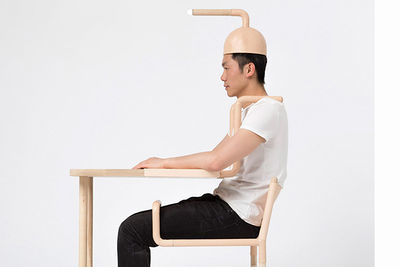
The object what we want to make is in our optics just a knitting machine that used to look like a normal human that is knitting with knitting needles. We use our global visual culture as humans to form a product that we combine with transparency till we create an object related to humans. This object is more than the conceptual part of visualising the human handling in a human handling knitting machine. This machine will able to fail. but also very human to fail also we don't know what the human the environment will do.
change of plans
We start a bit slow for sure, but we didn't find out what now the central meaning was of our project. The reason was that suzanne and i didn't know what we want to choose. Between the normal knitting machine or the open knit machine. I'm glad we make the desision to do nothing with both of it. Not because we didn't like it or it was not strong enough for a project. I really liked both knitting machines but I thought it would be interesting to explore electronics and the making culture without making textiles. For me its also to explore the world besides just fashion and find out if projects with just electronics with fid me better. We find a other project in it. When we worked with the open knit every one ask us what is this machine doing? When we said it is a knitting machine people where a bit surprised and ask how do it knit than?
After working with the open knit we came with a other project based on the open knit machine. Why do we have objects in life that don't look anymore what it suppose to be, how we humans used it before? Objects and products keep getting more design and are starting to be more about how it looks and not how it works. And the products are starting to look more like art objects than user-friendly products. For example the knitting machine, it its a machine what's not like the human craft is was before. What if the knitting machine what a robot and try to find a way in the human craft. or pretend is is a human, like the natural human movement of the body. maybe it is very awkward for a machine to do the human thing because he don't know how to knit or otherwise the human want to help the machine to leant how to knit on a human way. or both of them are very awkward with the idea that a machine try to do a human thing without performing. Maybe the human gets mad on the machine because it go's to slow. or don't learn to fast like a baby. it cost time to reshape, of learn the concept to become something in life. also it can be some weird thing when old machines give a life as knitter machines, a without performing for machines how to old to function. a retirement home for machines or a kindergarten
When we talk about a machine without human feelings, but with a human movement, trying to have the similar moving as humans. than we talking about the machine but when as the machine doing to preform a human movement and the human know how to help this machine. what will be the relation of the human with this machine?
Suzanne and I will exploring in this project a the human handling in a knitting machine, the relation between the imagination of a object and the machine, aesthetic experience of the human and machine the relation between human and the machine or the otherwise. Will the human help, to knit? or are the awkward with the fact the machine don't want to lat help? and how will it fit in a human behaviour were this machine not will existing only in imagination. When they looked at the machine they didn't think about a knitting machine and didn't really understand how this weird looking machine could knit. Knitting did not really evolved during the years, we have knitting machines and on kickstarter there is a complet digital knitting machine but knitting is existing for so many years and it evolved very slow. In everybody mind it didn't evolve at all the most people still just think about the knitting needles and knitting with you're hands ( and grandmas) . Also big knitted sweaters is the main thing people think about if you talk about knitting, and most are very surprised when you tell them there t-shirt is knitted as well. The human movement is still stuck in everybody's mind. Knitting will always be a human thing and a human movement for most people. What if we make the human movement of knitting a machine movement. Would it knit? would people recognize it as a actual knitting machine or would it look like an awkward machine?.
This image gives a great example of a machine doing a human activity, and the image looks weird, this machine is not made for this and why would a machine do this and not a human? Is this how the future is going to look?.
This tableware is form Aldo Bakker and these products do not look like the tableware were used to, and looks more like art.
the how do we imagination a knitting machine - drawings
start printing and prototyping
making a robot arm, starting 3D printing and look at the Arduino skills to let it move.
The robot arm first experiment looks like a real machine. but it is hopefully abel to move like a normal hand.
His first steps as a machine and the reaction of my dad he thinks it is a pet.

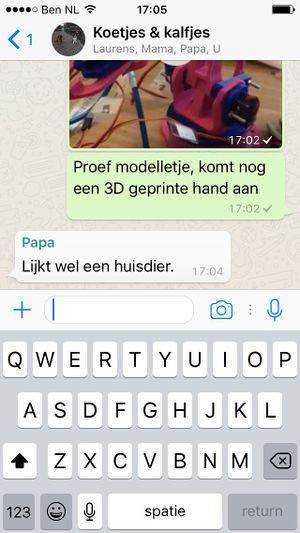
trying to make a application for the knitting needle
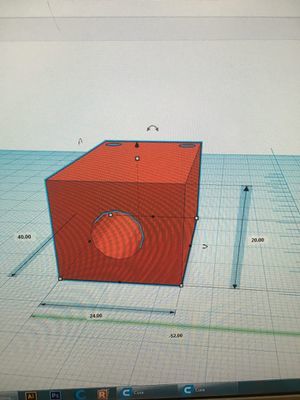
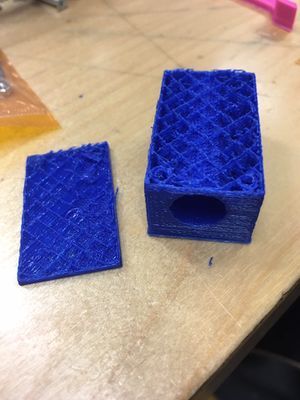
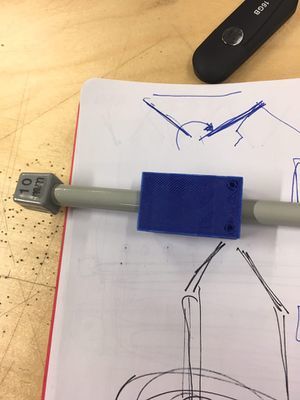
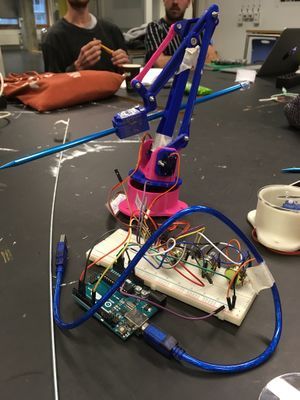
inspiration
The Knitting Machine, - dave cole 2005
Functional Installation with Acrylic Felt and Excavator [4]
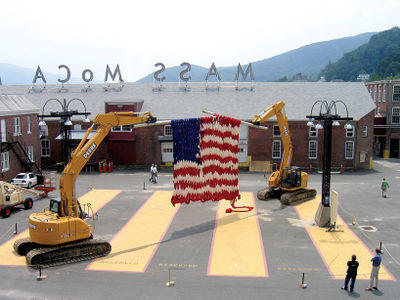
One and Three Chairs - Joseph Kosuth - 1965 [5] [6]
as a photograph, and as a copy of a dictionary entry for the word “chair.”
The installation is thus composed of an object, an image, and words.
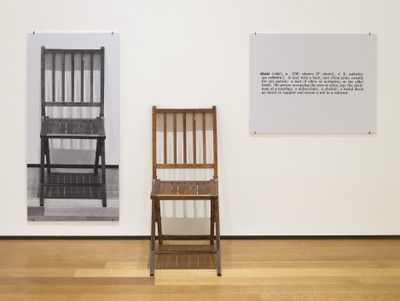
Untitled by John LeKa -, 1991, ladder and wheelchair [7]
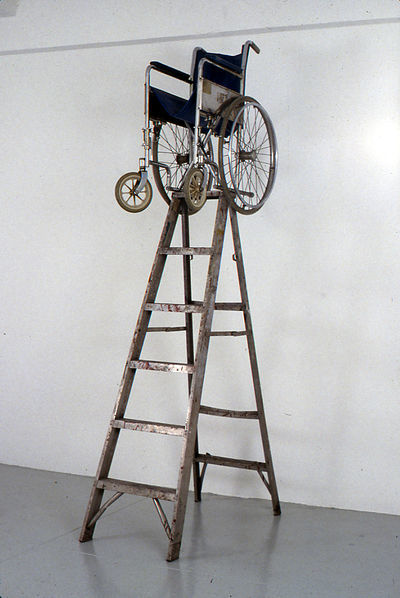
Tender - kipfilet tinder [8]
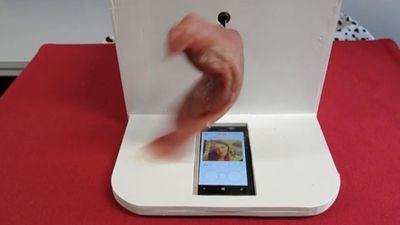
Hans Haacke - Condention Cube - 1963-65 - book conceptual art [9]
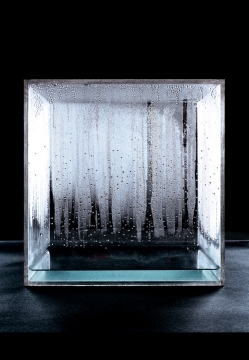
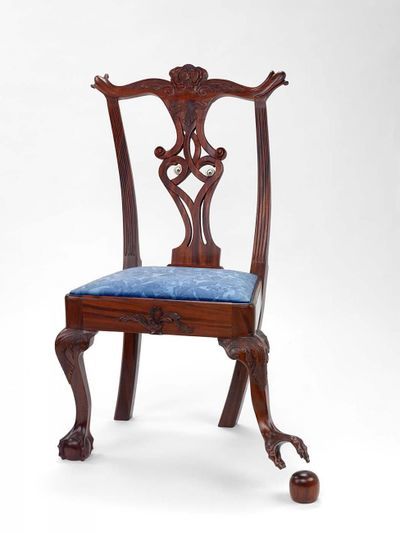
Oops
Jake Cress
2002
cut and hand-carved mahogany
it lost its ball, and it doesn’t want anyone to know! Look how quietly it’s sneaking out its foot. Hoping to get it back before anyone notices.
Emotional design
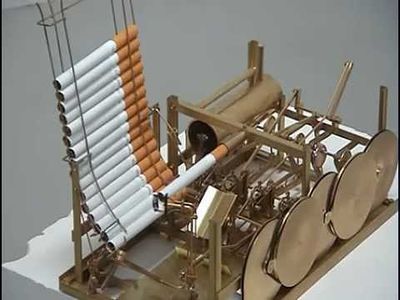
Smoking machine
2007
Kristoffer Myskja
nothing more than smoke cigarettes over and over again, a quite pointless action, but a really awesome piece of machinery.

the Roomba is a vacuum cleaner, its shape appropriate for running around the floor and maneuvering itself under the furniture. This robot doesn’t look like either a person or an animal, nor should it: its shape fits the task
emotion design
links
"BOOKS"
Hertzian Tales - Anthony Dunne - ISBN: 9780262042321
Design Noir: The Secret Life of Electronic Objects - Anthony Dunne and Fiona Raby - ISBN-10: 3764365668
Critical Design in Context: History, Theory, and Practices - Matt Malpass - ISBN: 9781472575180
Shaping things- Bruce Sterling - ISBN: 9780262693264
Objects of Desire: Design and Society Since 1750 - Adrian Forty - ISBN: 9780500274125
Objects of desire: the modern still life - Margit Rowell
The Design of Everyday Things - Don Norman - ISBN: 9781452654126
Emotional Design: Why We Love (or Hate) Everyday Things - Don Norman - ISBN 9780465051366 0465051367
The politics of design : a (not so) global manual for visual communication - Ruben Pater - ISBN 9789063694227
Conceptual Art - Peter Osborne - ISBN 0714839302
"WEBSITES"
about opendesign:
http://www.jessehoward.net/
http://www.jessehoward.net/
http://www.intrastructures.net/Intrastructures/Analysis_files/DesignForAdaption.pdf
about knitting:
about optjects:
open source:
https://github.com/g3rard/OpenKnit/blob/master/Wally120/Arduino/Wally120_WIP/Wally120_WIP.ino
https://www.thingiverse.com/thing:1015238
Design improvisation:
https://www.designboom.com/design/the-improvisation-machine-by-annika-frye/
link youtube and vimeo:
Dave Cole: The Knitting Machine -https://vimeo.com/28618663
link pictures:
https://www.designboom.com/art/david-cole-music-box-singer-knitting-machine/
https://www.moma.org/learn/moma_learning/joseph-kosuth-one-and-three-chairs-1965
https://en.wikipedia.org/wiki/John_LeKay
https://vimeo.com/111997940
